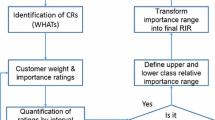Abstract
Quality function deployment (QFD) provides a systematic methodology to assist companies in developing quality products that are able to satisfy customer needs. The house of quality (HOQ), as the first phase of QFD, plays the most important role in product development. Frequently, fuzzy numbers are used to quantify the vagueness of linguistic terms so as to facilitate subjective assessments in the HOQ. However, the issue concerning how to determine the boundary intervals of fuzzy numbers remains unresolved. This work proposes a novel approach based on rough set theory, and introduces two concepts called rough number and rough boundary interval to address this issue. A comparative case study presented in this work shows that the proposed approach has significant advantages compared to the prevailing fuzzy number based method in processing subjective linguistic assessments in QFD.
Similar content being viewed by others
References
Cohen L (1995) Quality function deployment: how to make QFD work for you. Addison-Wesley, Reading, MA
Karsak E (2004) Fuzzy multiple objective decision making approach to prioritize design requirements in quality function deployment. Int J Prod Res 42/18:3957–3974
Moskowitz H, Kim K-J (1997) QFD optimizer: a novice friendly quality function deployment support decision-support system for optimizing product designs. Com and Ind Eng 32:641–655
Khoo L-P, Ho N-C (1996) Framework of a fuzzy quality function deployment system. Int J Prod Res 34/2:299–311
Chan L-K, Wu M-L (2005) A systematic approach to quality function deployment with a full illustrative example. Omega 33:119–139
Chan L-K, Wu M-L (1998) Prioritizing the technical measures in quality function deployment. Qual Eng 10:467–479
Hauser J, Clausing D (1988) The house of quality. Harv Bus Rev 66:63–73
Akao Y (1990) Quality function deployment: integrating customer requirements into product design. Maple-Vail, Portland
Griffin A, Hauser JR (1993) The voice of the customer. Mkt Sci 12(1):1–27
ReVelle JB, Moran JW, Cox CA (1998) The QFD handbook. Wiley, New York
Temponi C, Yen J, Tiao W-A (1999) House of quality: a fuzzy logic-based requirements analysis. Eur J Oper Res 117:340–354
Chen L-H, Weng M-C (2003) A fuzzy model for exploiting quality function deployment. Math Com Mod 38:559–570
Chan L-K, Kao H-P, Ng A, Wu M-L (1999) Rating the importance of customer needs in quality function deployment by fuzzy and entropy methods. Int J Prod Res 37/11:2499–2518
Zhou M (1998) Fuzzy logic and optimization models for implementing QFD. Com Ind Eng 35:237–240
Wang J (1999) Fuzzy outranking approach to prioritize design requirements in quality function deployment. Int J Prod Res 37/4:899–916
Shen X-X, Tan K-C, Xie M (2001) The implementation of quality function deployment based on linguistic data. J Intell Manuf 12:65–75
Vanegas L, Labib A (2001) A fuzzy quality function deployment (FQFD) model for deriving optimum targets. Int J Prod Res 39/l:99–120
Roder A, Tibken B (2006) A fuzzy optimization model for QFD planning process using analytic network approach. Eur J Oper Res 169(3):1010–1029
Kim K, Kim D, Min D (2007) Robust QFD: framework and a case study. Quali and Reli Eng Int 23(1):31–44
Pawlak Z (1982) Rough sets. Int J Com Info Sci 11/5:341–356
Pawlak Z (1991) Rough sets-theoretical aspects of reasoning about data. Kluwer Academic Publishers, Dordrecht
Khoo L-P, Tor S-B, Zhai L-Y (1999) A rough-set based approach for classification and rule induction. Int J Adv Manuf Tech 15:438–444
Greco S, Matarazzo B, Slowinski R (2001) Rough sets theory for multicriteria decision analysis. Eur J Oper Res 129:1–47
Alefeld G, Herzberger J (1983) Introduction to interval computations. Academic Press, New York
Moore RE (1979) Methods and applications of interval analysis. SIAM, Philadelphia
Kearfott RB, Kreinovich V (1996) Applications of interval computations. Kluwer Academic Publishers, Dordrecht
Author information
Authors and Affiliations
Corresponding author
Rights and permissions
About this article
Cite this article
Zhai, LY., Khoo, LP. & Zhong, ZW. A rough set enhanced fuzzy approach to quality function deployment. Int J Adv Manuf Technol 37, 613–624 (2008). https://doi.org/10.1007/s00170-007-0989-9
Received:
Accepted:
Published:
Issue Date:
DOI: https://doi.org/10.1007/s00170-007-0989-9




